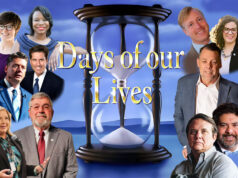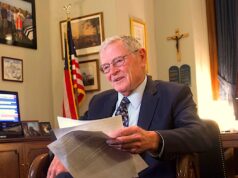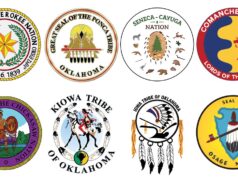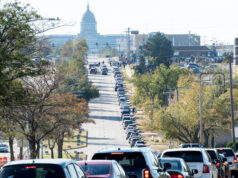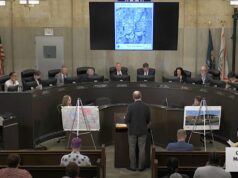

As the COVID-19 novel coronavirus continues its spread across the United States, adjustments to daily life have become the new norm, and the storylines worth following are now changing more often than your underwear: at least once a day.
As we did last week, we’ve gathered the following filtered news blurbs that represent key components of the COVID-19 news story in Oklahoma. If you want more information about any particular bullet point or paragraph, click the associated hyperlink to find the source of the information.
The Spread
As testing availability increases in Oklahoma (more on that shortly), the number of identified COVID-19 cases will also go up. But higher numbers — 429 cases, 140 hospitalizations, 16 deaths as of Sunday — also represent spread of the novel coronavirus across Oklahoma. With 44 out of 77 counties now having at least one confirmed case, health experts and members of the Oklahoma House of Representatives are reminding the public that the worst is yet to come.
“Expect confirmed cases, hospitalizations and deaths to continue rising. Officials have indicated Oklahoma’s peak will occur in April or May,” House Majority Floor Leader Jon Echols (R-OKC) posted via Facebook on Sunday. “The state epidemiologist and modeling experts from OU and OSU are close to producing a model predicting when Oklahoma’s COVID-19 surge will occur. This model will be used to marshal resources to meet the expected peak demand for services.”
Across the nation as other models come to fruition, reports on the virus’ impact are becoming almost impossible to comprehend. In New Jersey, about 700 police officers have tested positive.
The following sites can be used to keep tabs on broader COVID-19 numbers:
- The Oklahoma State Department of Health’s tracking page;
- The Johns Hopkins Coronavirus Resource Center;
- The World Health Organization’s map.
But the WHO’s data has also faced criticism, and the OSDH’s limited ability to test for COVID-19 in recent weeks has meant a likely disproportionate number of hospitalizations and death rate. Still, the Washington Post profiled the response in a small Oklahoma town, and Oklahoma’s health-data reporting was praised Sunday by the Charlotte Observer’s editorial board.
One specific population drawing concern over the weekend are the inmates of the Oklahoma Department of Corrections. The Oklahoma Policy Institute, Oklahomans for Criminal Justice Reform and the Oklahoma chapter of Americans for Prosperity are among nine groups that have pitched a proposed plan to the Stitt administration intended to reduce risk of outbreak among those incarcerated.
The Orders
Gov. Kevin Stitt issued a new amendment to his executive order Sunday night. The update requires a 14-day self-quarantine for anyone who travels to Oklahoma from New York, New Jersey, Connecticut, California, Louisiana or Washington. It also requires any delivery persons at hospitals to comply with screening requests, and it prohibits discrimination in housing or child care for health care employees.
Although Stitt implemented conditional shelter-in-place and business restriction executive orders last week, he drew criticism for limiting his “safer at home” directions to those age 65+ and those with underlying health conditions. He also confused some and aggravated others when his initial classification of “essential” businesses that could remain open ballooned a day later. The Oklahoma State Senate’s Democratic Caucus issued a statement Sunday morning thanking Stitt for his efforts while asking him to implement a statewide shelter-in-place policy regardless of age. Meanwhile, municipalities with climbing COVID-19 infection rates continue to implement their own more stringent policies, such as:
- Norman Mayor Breea Clark instituted a citywide “stay-at-home” restriction for all residents starting March 26 and lasting — for now — through April 14.
- OKC Mayor David Holt implemented a largely similar shelter-in-place order starting March 29, and Tulsa Mayor G.T. Bynum did the same. Both orders run through April 16, for now.
- Stillwater is expected to implement its version after today’s 5:30 p.m. City Council meeting, which will feature both an in-person meeting and videoconference access, according to its agenda.
The Testing
Troubles with COVID-19 testing in the United States have been well-documented. Initial delays at the federal level left states with a limited number of approved testing kits, and then an international shortage of testing reagent exacerbated problems while the virus took hold along the east and west coasts. With COVID-19’s continued spread throughout the entire country, each individual state has been competing for testing supplies, federal approval for alternative laboratories and innovative agreements to expand testing access.
Friday, Stitt and OSU Center for Health Sciences President Kayse Shrum (who also serves on the governor’s cabinet) said Oklahoma had bypassed federal sources to obtain necessary reagent intended to help reach the state’s goal of testing an additional 10,000 people. Private laboratories have also been contracted to increase Oklahoma’s testing capacity, with Stitt saying about 300 tests done on hospitalized people were awaiting processing at a private lab.
Other efforts to expand testing are underway, including:
- FDA “emergency clearance” for an expedited COVID-19 test that does not require a laboratory;
- FDA waivers for OSU laboratories that can do “automated testing” at a higher rate than some other laboratories;
- The expansion of mobile COVID-19 testing centers into northwest and southwest Oklahoma.
#Oklaed-ucation
The spring semester of 2020 has been upended, derailed and thrown into an experimental reality thanks to COVID-19. State colleges and universities have transitioned to online classes, with graduation ceremonies postponed for now. Elementary, middle and high school students are also adjusting to a new normal under the developing frameworks of “distance learning,” which can mean different things in different school districts. Consider the following:
- College students, professors and administrators across Oklahoma are adjusting to online-only instruction. “It doesn’t feel as bad as it could be,” says one student.
- As Oklahoma school districts develop their own “distance learning” strategies, several schools are preparing to use some worksheets, storybooks and other printed materials to ensure students who lack internet access can remain engaged.
- Epic Charter Schools — Oklahoma’s largest pair of virtual learning schools — are planning to resume digital instruction for their students statewide on April 6, according to discussion during the schools’ board meetings last week. Epic’s boards may have been the first in the state to utilize expanded opportunities for videoconferencing under a temporary law passed by the Legislature. The online charter K-12 is also expected to resume classes April 6.
The Stimulus
As the coronavirus has led to widespread shutdowns, America has started to see catastrophic economic repercussions: Unemployment claims have spiked, and the stock market has taken a nosedive. Many industries have screeched almost to a halt.
In an effort to counteract these effects (and after some last-minute drama when Thomas Massie, a libertarian-leaning Republican congressman from Kentucky, tried to force all the members of the House to return to Washington for a roll-call vote), Congress passed a $2 trillion economic stimulus bill, the largest such measure in American history. The package includes loans for distressed businesses, an expansion of unemployment benefits, aid for hospitals and health care providers and — perhaps the most talked-about provision — funds for stimulus checks of $1,200 to most people who make less than $75,000 a year. To understand more about the package, consider:
- The New York Times has published a helpful Q & A with more information about eligibility for stimulus payments and unemployment.
- Speaking to the Oklahoman on March 27, U.S. Sen. James Lankford explained said it’s not yet known how much funding from the bill will come to the state, as payments to cities and states will be based on reimbursements for expenses incurred fighting the virus.
- The package includes $10 billion for the country’s tribal nations. The Indian Health Service reported that, as of March 26, there were 110 confirmed cases of COVID-19 in facilities it oversees, including four cases in its Oklahoma City region.









